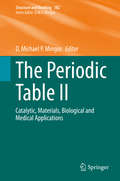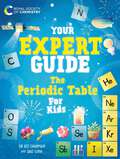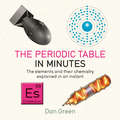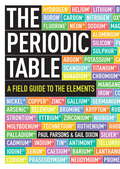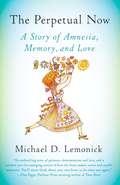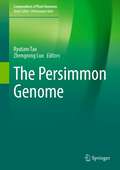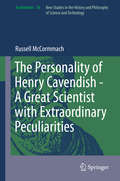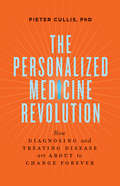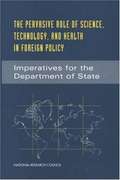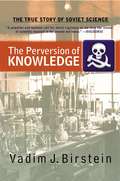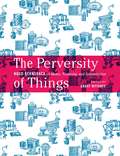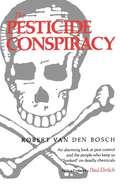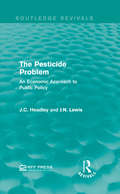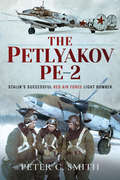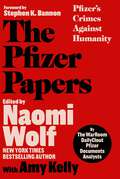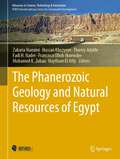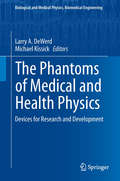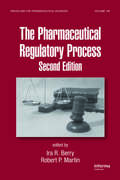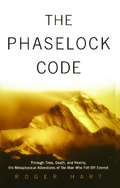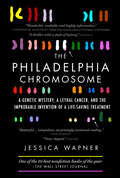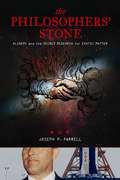- Table View
- List View
The Periodic Table II: Catalytic, Materials, Biological and Medical Applications (Structure and Bonding #182)
by D. Michael P. MingosAs 2019 has been declared the International Year of the Periodic Table, it is appropriate that Structure and Bonding marks this anniversary with two special volumes.In 1869 Dmitri Ivanovitch Mendeleev first proposed his periodic table of the elements. He is given the major credit for proposing the conceptual framework used by chemists to systematically inter-relate the chemical properties of the elements. However, the concept of periodicity evolved in distinct stages and was the culmination of work by other chemists over several decades. For example, Newland’s Law of Octaves marked an important step in the evolution of the periodic system since it represented the first clear statement that the properties of the elements repeated after intervals of 8. Mendeleev’s predictions demonstrated in an impressive manner how the periodic table could be used to predict the occurrence and properties of new elements. Not all of his many predictions proved to be valid, but the discovery of scandium, gallium and germanium represented sufficient vindication of its utility and they cemented its enduring influence. Mendeleev’s periodic table was based on the atomic weights of the elements and it was another 50 years before Moseley established that it was the atomic number of the elements, that was the fundamental parameter and this led to the prediction of further elements. Some have suggested that the periodic table is one of the most fruitful ideas in modern science and that it is comparable to Darwin’s theory of evolution by natural selection, proposed at approximately the same time. There is no doubt that the periodic table occupies a central position in chemistry. In its modern form it is reproduced in most undergraduate inorganic textbooks and is present in almost every chemistry lecture room and classroom. This second volume provides chemists with an overview of the important role played by the Periodic Table in advancing our knowledge of solid state and bioinorganic chemistry. It also illustrates how it has been used to fine-tune the properties of compounds which have found commercial applications in catalysis, electronics, ceramics and in medicinal chemistry.
The Periodic Table for Young Scientists (Your Expert Guide #1)
by Dr Dr Kit ChapmanFrom a top expert in the world of science comes this definitive guide to the Periodic Table, published in partnership with the Royal Society of Chemistry.In Your Expert Guide: The Periodic Table, discover the origins and genius of the Periodic Table: how the idea came about, what each symbol means and how it underpins our understanding of matter, materials and the study of chemistry. Explore the elements at work in our world and get a clear picture of the Periodic Table's role in explaining the building blocks of the Universe.Written by Dr Kit Chapman, award-winning science journalist, academic at Falmouth University and global science communicator. Published in partnership with The Royal Society of Chemistry, the internationally renowned nonprofit organisation with the same mission since 1841: to advance excellence in the chemical sciences. With lovely artwork by Dao Linh, see the elements come alive for curious readers aged 8+.Books in the Your Expert Guide series:With the Royal Society of Chemistry: The Periodic Table and Chemistry for Young ScientistsWith the Royal Society of Biology: The Human Body and Biology for Young ScientistsWith the Institute of Physics: The Universe for Kids and Physics for Young Scientists
The Periodic Table in Minutes (In Minutes)
by Dan GreenAn icon of science, the Periodic Table defines the fundamental chemistry of everything in the universe. In this compact yet comprehensive guide, Dan Green outlines the history, development and workings of the table, shows how its design reflects and illuminates the organisation of all matter, and even explains what it has to tell us about the chemistry of distant stars and of our own bodies. Contents include an individual entry for every known element? detailing properties, uses and key data, and sections on the patterns and groups of the famous table, as well as explanations of basic chemistry concepts such as elements and compounds, atomic structure, chemical bonds, reactions and radioactivity, amongst many others.
The Periodic Table: A Field Guide to the Elements
by Paul Parsons Gail DixonThe Periodic Table is one of the most recognizable images in science - and in our culture. Its 118 elements make up everything on our planet and in the entire universe. But how many of us actually know how to interpret its distinctive design? And what does its unique arrangement tell us about the behaviour of each element in the world around us? The Periodic Table looks at the fascinating story and surprising history of each of these elements, from the little-known uses of gold in medicine to that of arsenic as a wallpaper dye in the ninteenth-century and the development of the hydrogen bomb. Packed with interesting facts and figures and helpful illustrations, this accessible guide will help the armchair chemist navigate through the different groups of elements - and discover the world afresh.
The Periodic Table: A Field Guide to the Elements
by Paul Parsons Gail DixonThe Periodic Table is one of the most recognizable images in science - and in our culture. Its 118 elements make up everything on our planet and in the entire universe. But how many of us actually know how to interpret its distinctive design? And what does its unique arrangement tell us about the behaviour of each element in the world around us? The Periodic Table looks at the fascinating story and surprising history of each of these elements, from the little-known uses of gold in medicine to that of arsenic as a wallpaper dye in the ninteenth-century and the development of the hydrogen bomb. Packed with interesting facts and figures and helpful illustrations, this accessible guide will help the armchair chemist navigate through the different groups of elements - and discover the world afresh.
The Perpetual Now: A Story of Amnesia, Memory, and Love
by Michael D. LemonickIn the aftermath of a shattering illness, Lonni Sue Johnson lives in a "perpetual now," where she has almost no memories of the past and a nearly complete inability to form new ones. The Perpetual Now is the moving story of this exceptional woman, and the groundbreaking revelations about memory, learning, and consciousness her unique case has uncovered. Lonni Sue Johnson was a renowned artist who regularly produced covers for The New Yorker, a gifted musician, a skilled amateur pilot, and a joyful presence to all who knew her. But in late 2007, she contracted encephalitis. The disease burned through her hippocampus like wildfire, leaving her severely amnesic, living in a present that rarely progresses beyond ten to fifteen minutes. Remarkably, she still retains much of the intellect and artistic skills from her previous life, but it's not at all clear how closely her consciousness resembles yours or mine. As such, Lonni Sue's story has become part of a much larger scientific narrative—one that is currently challenging traditional wisdom about how human memory and awareness are stored in the brain. In this probing, compassionate, and illuminating book, award-winning science journalist Michael D. Lemonick uses the unique drama of Lonni Sue Johnson's day-to-day life to give us a nuanced and intimate understanding of the science that lies at the very heart of human nature.
The Perpetuation of Living Beings
by Thomas Henry HuxleyEarly scientific work on heredity variance and genetic transmission.
The Persecuted Drug: The Story of DMSO
by Pat McgradyDMSO remains a truly amazing substance. It is a versatile solvent; it probably will dissolve more chemicals than any other solvent. It penetrates the skin and is in the bloodstream within seconds; and it carries many dissolved chemicals with it. It freezes at a couple of degrees below room temperature. As a runoff product of the paper industry, it is abundant and should be cheap. (With inflation and the middleman's profits, its price during the last half-dozen years has multiplied thirty fold. But considering its many uses, it still is cheap at the current $10 a pint.)
The Persimmon Genome (Compendium of Plant Genomes)
by Ryutaro Tao Zhengrong LuoThis book will expound the latest information on the current state of persimmon genomics and transcriptomics, with a particular focus on the latest findings and analysis in relation to the most important agronomic traits. The genus Diospyros contains about 400 species distributed all continents of the globe. Most of Diospyros species are distributed in the tropical and subtropical regions, while cultivated persimmon or simply kaki (Diospyros kaki) originates in East Asia and has been grown in China, Japan and Korea for many years. World production of persimmon has been increasing continuously since 1990s, with China being the most producer. Outside Asia, kaki production has been rapidly increasing in Spain in recent years. Because kaki is mostly hexaploid (2n = 6x =90) and its genome size is quite large with the flow cytometric analysis estimation of about 900 Mb, genetic and molecular studies in persimmon are quite complicated. Diploid close relatives of kaki, D. lotus and D. oleifera have been recently used as model species of kaki. Utilizing these species, molecular basis of several economically molecular basis of important traits such as sexuality and astringency has been studied, giving important information for kaki breeding.
The Personality of Henry Cavendish - A Great Scientist with Extraordinary Peculiarities
by Russell MccormmachProfiles the eminent 18th century natural philosopher Henry Cavendish, best known for his work in chemistry and physics and one of the most baffling personalities in the history of science. In these chapters we are introduced to the psychology of science and of scientists and we learn about Cavendish's life and times. His personality is examined from two perspectives: one is that he had a less severe form of autism, as has been claimed; the other is that he was eccentric and a psychological disorder was absent. Henry Cavendish lived a life of science, possibly more completely than any other figure in the history of science: a wealthy aristocrat, he became a dedicated scientist. This study brings new information and a new perspective to our understanding of the man. The scientific and non-scientific sides of his life are brought closer together, as the author traces topics including his appearance, speech, wealth, religion and death as well as Cavendish's life of natural philosophy where objectivity and accuracy, writing and recognition all played a part. The author traces aspects of Cavendish's personality, views and interpretations of him, and explores notions of eccentricity and autism before detailing relevant aspects of the travels made by our subject. The author considers the question "How do we talk about Cavendish?" and provides a useful summary of Cavendish's travels. This book will appeal to a wide audience, from those interested in 18th century history or history of science, to those interested in incidences of autism in prominent figures from history. This volume contains ample relevant illustrations, several interesting appendices and it includes a useful index and bibliography.
The Personalized Medicine Revolution
by Pieter CullisEvery one of us is unique. With recent advances in technology, we now know that that statement is more true that ever: we are each individuals, right down to a molecular level - a one-of-a-kind combination of genes, proteins, and metabolism. So why does healthcare still take a one-size-fits-all approach? The same methods are used on everyone to diagnose illness, and the same drugs are used to treat it - despite the fact that those methods and treatments are not effective for everyone and are even harmful for some. Shouldn't our medicine be tailored to our differences? The Personalized Medicine Revolution explores recent advances in genomics, the study of the human genome - as well as its cousins proteomics, metabolomics, microbiomics, and the like - and explains how technology is even now changing the way medicine is delivered. Along the way, it takes the reader through the five critical healthcare areas that will be transformed most radically by personalized medicine - prediction, prevention, diagnosis, treatment, and monitoring - and examines the practical and ethical issues involved. Finally, it details how readers can use personalized medicine to take charge of their own health and build a stronger and safer medical system.
The Pervasive Role of Science, Technology, and Health in Foreign Policy: Imperatives for the Department of State
by Technology Committee on Science Health Aspects of the Foreign Policy Agenda of the United StatesIssues involving science, technology, and health (STH) have moved to the forefront of the international diplomatic agenda. Other vital issues linked to technological developments pervade longer-range foreign policy concerns. Thus, STH considerations are often central to the Department of State’s bilateral and multilateral interactions with other governments. STH aspects play a large role in discussions of such critical topics as nuclear nonproliferation, use of outer space, population growth, adequate and safe food supply, climate change, infectious diseases, energy resources, and competitiveness of industrial technologies. In addressing these issues, expert STH knowledge is essential to the anticipation and resolution of problems and to the achievement of foreign policy goals. The Department, recognizing that it requires strengthened capabilities to address such an array of topics, asked for suggestions by the National Research Council as to how it could better deal with foreign policy issues with STH content.
The Perversion of Knowledge: The True Story of Soviet Science
by Vadim J. BirsteinDuring the Soviet years, Russian science was touted as one of the greatest successes of the regime. Russian science was considered to be equal, if not superior, to that of the wealthy western nations. The Perversion of Knowledge, a history of Soviet science that focuses on its control by the KGB and the Communist Party, reveals the dark side of this glittering achievement. Based on the author’s firsthand experience as a Soviet scientist, and drawing on extensive Russian language sources not easily available to the Western reader, the book includes shocking new information on biomedical experimentation on humans as well as an examination of the pernicious effects of Trofim Lysenko’s pseudo-biology. Also included are many poignant case histories of those who collaborated and those who managed to resist, focusing on the moral choices and consequences. The text is accompanied by the author’s own translations of key archival materials, making this work an essential resource for all those with a serious interest in Russian history.
The Perversity of Things: Hugo Gernsback on Media, Tinkering, and Scientifiction (Electronic Mediations #52)
by Hugo GernsbackIn 1905, a young Jewish immigrant from Luxembourg founded an electrical supply shop in New York. This inventor, writer, and publisher Hugo Gernsback would later become famous for launching the first science fiction magazine, Amazing Stories, in 1926. But while science fiction&’s annual Hugo Awards were named in his honor, there has been surprisingly little understanding of how the genre began among a community of tinkerers all drawn to Gernsback&’s vision of comprehending the future of media through making. In The Perversity of Things, Grant Wythoff makes available texts by Hugo Gernsback that were foundational both for science fiction and the emergence of media studies.Wythoff argues that Gernsback developed a means of describing and assessing the cultural impact of emerging media long before media studies became an academic discipline. From editorials and blueprints to media histories, critical essays, and short fiction, Wythoff has collected a wide range of Gernsback&’s writings that have been out of print since their magazine debut in the early 1900s. These articles cover such topics as television; the regulation of wireless/radio; war and technology; speculative futures; media-archaeological curiosities like the dynamophone and hypnobioscope; and more. All together, this collection shows how Gernsback&’s publications evolved from an electrical parts catalog to a full-fledged literary genre.The Perversity of Things aims to reverse the widespread misunderstanding of Gernsback within the history of science fiction criticism. Through painstaking research and extensive annotations and commentary, Wythoff reintroduces us to Gernsback and the origins of science fiction.
The Pesticide Conspiracy
by Robert Van Den BoschProfessor van den Bosch of the University of California was one of the developers of Integrated Pest Management—the use of biological controls, improved pest knowledge and observation, and judicious application of chemicals only when absolutely necessary. His research often suggested that less or no pesticides should be applied, which made him the target of both open and clandestine attack from industry and government figures. In protest, he wrote this passionate account of what Ecology called "the ultimate social disaster of: evolving pesticide-resistant insects, the destruction of their natural predators and parasites, emergent populations of new insect pests, downstream water pollution, atmospheric pollution, the 'accidental' killing of wildlife and people, and the bankruptcies of indigenous and small farmers."As a new Introduction to this edition recounts, some lessening of dangerous overreliance on massive pesticide applications has been achieved since van den Bosch published this book in 1978—partly as a result of its influence. But the structural problems he described remain. The book has thus become a classic, along with Rachel Carson's Silent Spring.
The Pesticide Problem: An Economic Approach to Public Policy (Routledge Revivals)
by J.C. Headley J.N. LewisThe widespread use of chemicals to control pests has resulted in adverse effects for both wildlife and humans. Originally published in 1967, this title seeks to clearly explain the key issues for understanding public policy in the pesticide problem. Authors Headley and Lewis provide simple clarification of the economic issues involved in creating public policy for pest control and present how policy formation for pesticides will be improved by further economic analysis. This title is a valuable and relevant resource for students interested in environmental studies, especially the impact of public policy making on the environment.
The Petlyakov Pe-2: Stalin's Successful Red Air Force Light Bomber
by Peter C. SmithThe definitive book on the development and deployment of the Soviet Union’s supreme dive-bomber—with rare archival and private photos.During the Second World War, the Petlyakov Pe-2 Peshka was the Soviet Union’s main dive- and light-bomber in operations across the Eastern Front. It became a mainstay of the Soviet counteroffensive that led to the fall of Berlin. They also led the way in the brief but annihilating Manchurian campaign against Japan in the closing days of the war in 1945.Conceived by a team of top aircraft designers whom Stalin had incarcerated on political charges, the Peshka had originally been designed as a high-altitude twin-engine fighter plane. But due to the outstanding success of the German Stukas in the Blitzkrieg, it was quickly transformed into the fastest dive-bomber in the skies.Only a handful had reached front lines by the start of Operation Barbarossa in June 1941. But by 1945, more than 11,000 of the type were built, including many variants. Many of these remained in service with the air forces of Yugoslavia and the Warsaw Pact countries into the 1950s. Using official sources, including the official Pe-2 handbook, as well as rare color and black-and-white photographs from both official and private collections, this is the definitive record of the Pe-2.
The Petlyakov Pe-2: Stalin's Successful Red Air Force Light Bomber
by Peter C. SmithThe definitive book on the development and deployment of the Soviet Union’s supreme dive-bomber—with rare archival and private photos.During the Second World War, the Petlyakov Pe-2 Peshka was the Soviet Union’s main dive- and light-bomber in operations across the Eastern Front. It became a mainstay of the Soviet counteroffensive that led to the fall of Berlin. They also led the way in the brief but annihilating Manchurian campaign against Japan in the closing days of the war in 1945.Conceived by a team of top aircraft designers whom Stalin had incarcerated on political charges, the Peshka had originally been designed as a high-altitude twin-engine fighter plane. But due to the outstanding success of the German Stukas in the Blitzkrieg, it was quickly transformed into the fastest dive-bomber in the skies.Only a handful had reached front lines by the start of Operation Barbarossa in June 1941. But by 1945, more than 11,000 of the type were built, including many variants. Many of these remained in service with the air forces of Yugoslavia and the Warsaw Pact countries into the 1950s. Using official sources, including the official Pe-2 handbook, as well as rare color and black-and-white photographs from both official and private collections, this is the definitive record of the Pe-2.
The Pfizer Papers: Pfizer's Crimes Against Humanity
by The WarRoom/DailyClout Pfizer Documents AnalystsThe Pfizer Papers features new reports written by WarRoom/DailyClout research volunteers, which are based on the primary source Pfizer clinical trial documents released under court order and on related medical literature. The book shows in high relief that Pfizer&’s mRNA COVID-19 vaccine clinical trial was deeply flawed and that the pharmaceutical company knew by November 2020 that its vaccine was neither safe nor effective. The reports detail vaccine-induced harms throughout the human body, including to the reproductive system; show that women suffer vaccine-related adverse events at a 3:1 ratio; expose that vaccine-induced myocarditis is not rare, mild, or transient; and, shockingly, demonstrate that the mRNA vaccines have created a new category of multi-system, multi-organ disease, which is being called &“CoVax Disease.&” Despite the fact that Pfizer committed in its own clinical trial protocol to follow the placebo arm of its trial for twenty-four months, Pfizer vaccinated approximately 95 percent of placebo recipients by March 2021, thus eliminating the trial&’s control group and making it impossible for comparative safety determinations to be made. Just as importantly, The Pfizer Papers makes it clear that the US Food and Drug Administration knew about the shortfalls of Pfizer&’s clinical trial as well as the harms caused by the company&’s mRNA COVID vaccine product, thus highlighting the FDA&’s abject failure to fulfill its mission to &“[protect] the public health by ensuring the safety, efficacy, and security of human and veterinary drugs, biological products, and medical devices.&” The Pfizer Papers offers an in-depth look at how Big Pharma, the US government, and healthcare entities stand protected behind the broad legal immunity provided by the Public Readiness and Emergency Preparedness Act (PREP Act) when creating, prescribing, and administering vaccines; and, under that shield of protection, do what is best for their bottom lines rather than for the health and well-being of Americans.
The Phanerozoic Geology and Natural Resources of Egypt (Advances in Science, Technology & Innovation)
by Zakaria Hamimi Haytham El Atfy Hassan Khozyem Thierry Adatte Fadi H. Nader Francisca Oboh-Ikuenobe Mohamed K. ZobaaThe Phanerozoic Geology and Natural Resources of Egypt includes a series of chapters written by highly qualified group of researchers whose expertise is recognized and appreciated not only in Egypt, but also in the world over. The chapters span a wide range of geological subdisciplines including tectonics, paleogeography, stratigraphy, sedimentology, paleontology, groundwater, and energy resources, just to name a few. In this regard, the book provides the reader with ample knowledge about the different facets of the fascinating and always intriguing geology of Egypt since the Precambrian time. For a junior researcher or a geoscience student, the book is a comprehensive, multidisciplinary one-stop resource that they will continue to reference and rely on for years to come. For a more experienced scientist, the book summarizes the current state of knowledge, highlights the magnitude of complexity of the geology of Egypt and northeast Africa, and reveals potential areas where future research should be directed. The book is written in simple, easy to understand English language and contains very useful high-quality illustrations. Last but not least, The Phanerozoic Geology and Natural Resources of Egypt has been reviewed and edited by world class, highly ranked geoscientists from Egypt, Europe, and USA.
The Phantoms of Medical and Health Physics
by Larry A. Dewerd Michael KissickThe purpose and subject of this book is to provide a comprehensive overview of all types of phantoms used in medical imaging, therapy, nuclear medicine and health physics. For ionizing radiation, dosimetry with respect to issues of material composition, shape, and motion/position effects are all highlighted. For medical imaging, each type of technology will need specific materials and designs, and the physics and indications will be explored for each type. Health physics phantoms are concerned with some of the same issues such as material heterogeneity, but also unique issues such as organ-specific radiation dose from sources distributed in other organs. Readers will be able to use this book to select the appropriate phantom from a vendor at a clinic, to learn from as a student, to choose materials for custom phantom design, to design dynamic features, and as a reference for a variety of applications. Some of the information enclosed is found in other sources, divided especially along the three categories of imaging, therapy, and health physics. To our knowledge, even though professionally, many medical physicists need to bridge the three catagories described above.
The Pharmaceutical Regulatory Process (Drugs and the Pharmaceutical Sciences)
by Ira R. Berry Robert P. MartinThis Second Edition examines the mechanisms and means to establish regulatory compliance for pharmaceutical products and company practices. It focuses on major legislative revisions that impact requirements for drug safety reviews, product regulatory approvals, and marketing practices. Written by top industry professionals, practicing attorneys, an
The Phaselock Code: Through Time, Death and Reality -- The Metaphysical Adventures of Man
by Roger HartONE MAN'S REMARKABLE SEARCH FOR THE ULTIMATE TRUTHS OF OUR WORLD. For Professor Roger Hart, life truly began after he almost lost his -- in a horrific fall off the slopes of Mount Everest that he miraculously survived. This near-death experience sparked a desire in him to devote his studies to the very nature of human consciousness, in order to unlock the code of reality that binds our world. On an adventure of discovery that would take him around the world, Hart would experience life-altering transcendental events in Tibet, Morocco, and Tierra del Fuego -- opening the door to a true understanding of the nature of man. In this groundbreaking volume, he explores the participation of consciousness in the creation of reality, challenging the traditional scientific view of time, space, and objectivity -- and describing in detail his own metaphysical journey, which has involved synchronicity, precognition, and telekinesis. It is an exploration of the very things that make us human -- and a quest that touches upon the meaning of life itself.
The Philadelphia Chromosome: A Genetic Mystery, A Lethal Cancer, And The Improbable Invention Of A Lifesaving Treatment
by Jessica WapnerOne of The Wall Street Journal’s 10 Best Nonfiction Books of the Year Philadelphia, 1959: A scientist scrutinizing a single human cell under a microscope detects a missing piece of DNA. That scientist, David Hungerford, had no way of knowing that he had stumbled upon the starting point of modern cancer research— the Philadelphia chromosome. It would take doctors and researchers around the world more than three decades to unravel the implications of this landmark discovery. In 1990, the Philadelphia chromosome was recognized as the sole cause of a deadly blood cancer, chronic myeloid leukemia, or CML. Cancer research would never be the same. Science journalist Jessica Wapner reconstructs more than forty years of crucial breakthroughs, clearly explains the science behind them, and pays tribute—with extensive original reporting, including more than thirty-five interviews—to the dozens of researchers, doctors, and patients with a direct role in this inspirational story. Their curiosity and determination would ultimately lead to a lifesaving treatment unlike anything before it. The Philadelphia Chromosome chronicles the remarkable change of fortune for the more than 70,000 people worldwide who are diagnosed with CML each year. It is a celebration of a rare triumph in the battle against cancer and a blueprint for future research, as doctors and scientists race to uncover and treat the genetic roots of a wide range of cancers.
The Philosopher's Stone
by Joseph P. FarrellProlific author Joseph P. Farrell, who commands a growing and devoted audience on Coast to Coast AM, Erskine Overnight, and other programs, initiates his Feral House association with The Philosopher's Stone, in which he demonstrates the connections of modern physics and ancient alchemy by investigating monatomic gold, the work of Russian astrophysicist Nikolai Kozyrev, and the fuel for the mysterious Nazi "Bell" device, Serum 525.Farrell's previous books investigated the scientific and astronomical implications of ancient monuments and the secret space operations of the Nazis who were brought into NASA to continue their highly classified research as a result of "Operation Paperclip." The author is now working with best-selling authors Richard C. Hoagland and Mike Bara on a book about secret American space programs.Chapters within The Philosopher's Stone include:The alchemical view of the physical mediumTransmutations and timeDavid Hudson's Monatomic GoldThe Platinum Group Metals and High Spin State AtomsAn Alchemical Examination of the Soviet Red Mercury LegendThe Physics of Rotation: Dr. Nikolai KozyrevH-Bombs and Torsion PhysicsThe Greater German Alchemical ReichNazis, Lasers, and Isotope EnrichmentThe Bell and Serum 525
